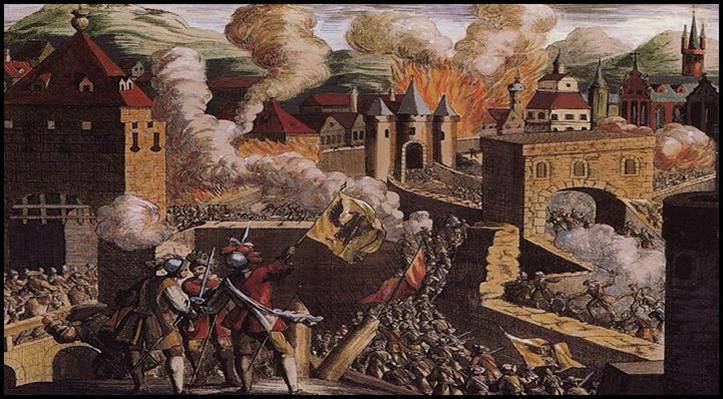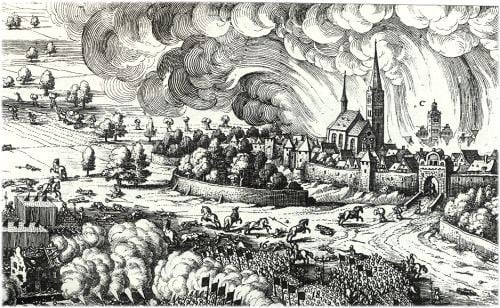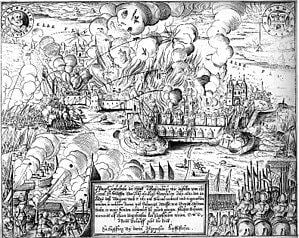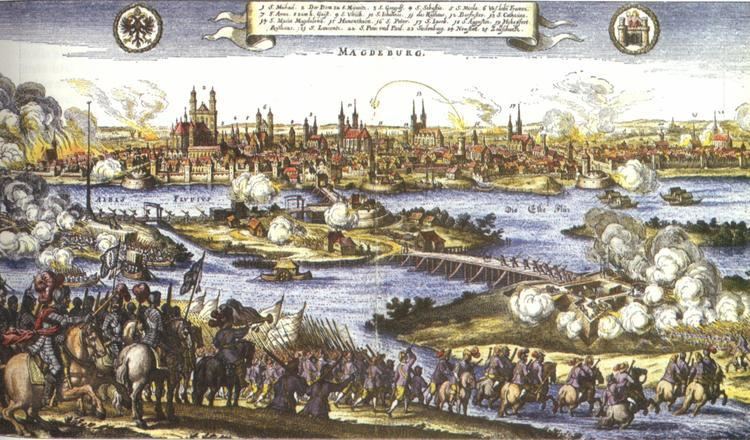24,000 2,400 Date 20 May 1631 | 300 killed1,600 wounded 25,000 inhabitants Result Destruction of the city | |
 | ||
Similar Thirty Years' War, Battle of Breitenfeld, Battle of Lutter, Battle of Sablat, Battle of Stadtlohn | ||
30 year s war sack of magdeburg
The Sack of Magdeburg (German: Magdeburgs Opfergang or German: Magdeburger Hochzeit) refers to the siege, the subsequent plundering, and the massacre of the inhabitants of the largely Protestant city of Magdeburg by the forces of the Holy Roman Empire and the Catholic League during the Thirty Years' War. The siege lasted from November 1630 until 20 May 1631.
Contents

Background

The Thirty Years' War had been raging for a dozen years by the time that the imperial city of Magdeburg rose up against the Holy Roman emperor. The city's councillors had been emboldened by King Gustavus Adolphus's landing in Pomerania on 6 July 1630: the Swedish king was a Lutheran Christian, and many of Magdeburg's residents were convinced that he would aid them in their struggle against the Roman Catholic Habsburg emperor, Ferdinand II. Not all Evangelical rulers within the Holy Roman Empire had immediately embraced Adolphus, however; some believed his chief motive for entering the war was to take northern German ports, which would allow him to control commerce in the Baltic Sea. Yet the city of Magdeburg had additional good reason to ally itself with him: the Swedish army was one of the most efficient of the time, and Gustavus Adolphus did not rely on mercenaries as much as other rulers did. His army consisted primarily of his Swedish countrymen, but the armies of the Holy Roman emperor were a mix of Hungarians, Croats, Spaniards, Poles, Italians, Frenchmen, Germans, and others.

In a matter of months, imperial forces under the command of the Count of Tilly laid siege to the city.
Assault and sacking
On the last day of the siege Magdeburg's councilors were convinced that it was time to sue for peace, but word of their decision did not reach the Count of Tilly in time. The siege was ended and Imperial Field Marshal Gottfried Heinrich Graf zu Pappenheim, and Johann Tserclaes, Count of Tilly, attacked Magdeburg for its rich stores of goods. The city's fortifications were breached and imperial forces were able to overpower armed opposition and open the Kröcken Gate which allowed the entire army to enter the city. The city was dealt another blow when Colonel Dietrich von Falkenberg, a nobleman sent by King Gustavus to direct Magdeburg's military affairs, was shot dead by Catholic imperials. When the city was almost lost, the garrison mined various places and set others on fire. After the city fell, the Imperial soldiers went out of control and started to massacre the inhabitants and set fire to the city. The invading soldiers had not received payment for their service and took the chance to loot everything in sight; they demanded valuables from every household that they encountered. Otto von Guericke, an inhabitant of Magdeburg, claimed that when civilians ran out of things to give the soldiers, "the misery really began. For then the soldiers began to beat, frighten, and threaten to shoot, skewer, hang, etc., the people." It took only one day for all of this destruction and death to transpire. Of the 30,000 citizens, only 5,000 survived. For fourteen days, charred bodies were carried to the Elbe River to be dumped to prevent disease.
In a letter, Pappenheim wrote of the Sack:
I believe that over twenty thousand souls were lost. It is certain that no more terrible work and divine punishment has been seen since the Destruction of Jerusalem. All of our soldiers became rich. God with us.
Aftermath
After Magdeburg's capitulation to the imperial forces, there was much bickering between the residents who had favored resistance against the emperor and those who had been against such an action. Even Adolphus joined in the finger pointing, claiming that the citizens of Magdeburg had not been willing to pay the necessary funds for their defense. The imperial treatment of defeated Magdeburg helped persuade many Evangelical Christian rulers in the Holy Roman Empire to stand against the Roman Catholic emperor.
At the time of the Peace of Westphalia, ending the war in 1648, the city's population had further dropped so that only 450 people were still living in the city.
The devastation was so great that Magdeburgisieren (or "magdeburgization") became an oft-used term signifying total destruction, rape, and pillaging for decades. The terms "Magdeburg justice", "Magdeburg mercy" and "Magdeburg quarter" also arose as a result of the sack, used originally by Protestants when executing Roman Catholics who begged for quarter.
